DAY OF ERUPTION
What you need to know about the guitar solo that changed the world of guitar and the man who wrote it.
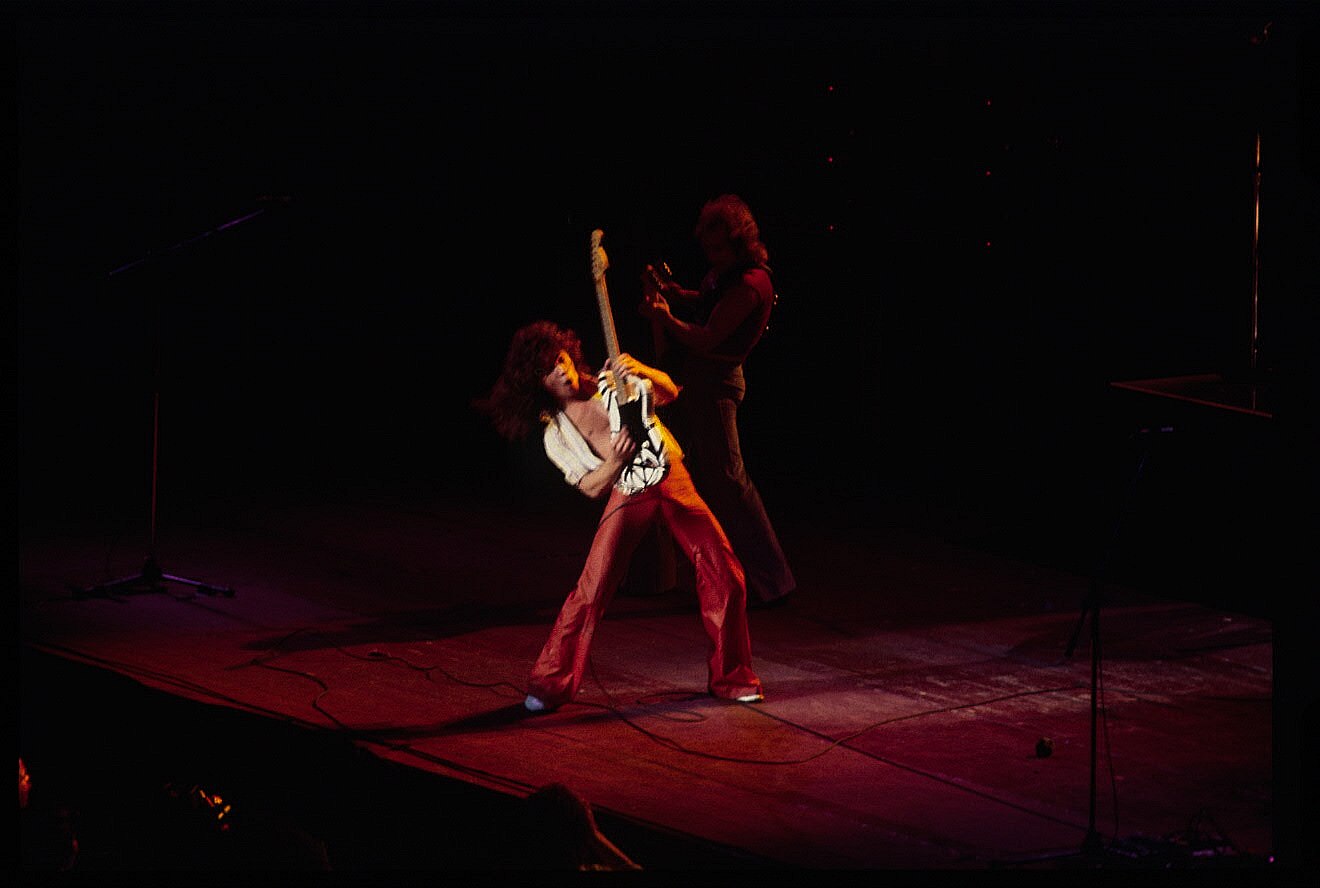
What you need to know about the guitar solo that changed the world of guitar and the man who wrote it.
Eruption is a guitar solo track written and performed by Eddie Van Halen in 1978 and appears first on Van Halen I. It is widely considered the most influential guitar solo of all time. Eddie’s unique style of guitar playing, which includes tapping, redefined the landscape of hard rock and heavy metal music. Eruption is a blistering, sonic explosion of guitar innovation and feel that catapulted Eddie into the conversation of the greatest guitarists of all-time.
I am sure the neighbors had plenty of names for the Van Halen brothers Eddie and Alex as they tore through 1960’s Pasadena.
Eddie Van Halen was born in Amsterdam in 1955, Edward’s family moved to the US when he was just 7 years old. A triumphant story of immigration, the struggles of being a minority and the American Dream are told through his inspiring interview with the Smithsonian.
Ed was a kid who never actually wanted to play guitar. Though the nudging of his Mother had him playing piano first, his real infatuation with music started with playing the drums.
It was his brother, Alex, who first heard what we all hear now, a natural guitarist.
While playing guitar, Edward Van Halen made his name known and inspires generation of music fans. An industry disruptor turned hero, a desperate innovator that transformed into a legend. Ed, Eddie, Edward, EVH are all names that, when mentioned in music circles, bring an immediate mental picture to mind.
“But Ted did do something remarkable on our debut that I’ll always be grateful for. He got “Eruption” on the record. That guitar solo alone is worth the price of admission. And the whole thing happened by accident…”
Consider this a call to all guitar players and musicians of critical-claim, genre, and space. Air-guitarists of every age. Every radio programmer, online music streaming service, music platform, and all things guitar.
It is now time to recognize January 26th, the date of Edward Van Halen’s birth, as an official Day of Eruption.
A pledge to play, shred, and share (#DayofEruption) the epic piece that inspired all beings with feeling and changed all things six-string. A tribute to Edward Van Halen that fills every air-wave, practice pad, jam space, rehearsal hall, music store, guitar shop, and online collaboration. And, maybe, one day a festival that rivals the sold out Van Halen shows we all enjoyed.
Eddie Van Halen’s guitar sound was unique due to a combination of factors, including his self-built guitar, the Frankestrat, his amp, effects, and his innovative and never-satisfied approach to artistry. The sounds produced in his iconic guitar solo, Eruption, were raw and powerful, showcasing his remarkable dexterity and exploitation of guitar techniques.
The Frankestrat played a significant role in Eddie Van Halen’s unique sound. This self-built guitar was a combination of a Fender Stratocaster and Gibson PAF humbucker pickups, which allowed him to achieve a distinctive tone. The guitar was also equipped with a Floyd Rose locking tremolo system, which enabled him to perform dive bombs and other unique effects.
Eddie Van Halen’s amp and effects also played a crucial role in his sound. He used a variety of amps, including a Marshall Super Lead and a Fender Super Reverb, which he modified to suit his needs. He also used effects such as a MXR Phase 90 and a flanger pedal, which he used to create a swirling texture in his music.
Eddie Van Halen’s innovative approach to artistry was another factor that contributed to his unique sound. He constantly experimented with new techniques and sounds, pushing the boundaries of what was possible on the guitar. This approach allowed him to create a sound that was entirely his own, one that has influenced countless guitarists since.
In conclusion, Eddie Van Halen’s unique guitar sound was the result of a combination of factors, including his self-built guitar, his amp and effects, and his innovative approach to artistry. The sounds produced in his iconic guitar solo, Eruption, were raw and powerful, showcasing his remarkable dexterity and exploitation of guitar techniques. His sound remains an inspiration to guitarists around the world, and his legacy continues to influence the world of music today.
The historical impact of EVH across the cultural spectrum was memorialized when Edward’s original black and white guitar and 1978 Touring guitar rig were part of The Metropolitan Museum of Art’s “Play it Loud” exhibit in 2019 and recognized as artifacts of Americana at The Met in New York City, the largest art museum in the Americas and the most visited museum in the United States.
An exact replica of Edward’s original guitar now resides in the Smithsonian National Museum of American History. “The museum collects objects that are multidimensional, and this guitar reflects innovation, talent and influence,” said Brent D. Glass, director of the museum.
Quickly approaching 50 years since its release, Eruption continues its pyroclastic flow of inspiration. Commanding the attention of anyone and everyone within earshot interested in creativity, music, and guitar. Continually hailed as one of the greatest guitar solos of all-time, Eruption compels with a melding of authentic, innovative style. Its booming confidence brought to life, ripples with boundless influence, extending beyond genres and the fields of music and arts.
Mesmerizing aspiring musicians, no single guitar solo or player changed the way a guitar is perceived, played, and listened to the degree the Edward did on Eruption. It continues to inspire all that listen with a feeling of permission, to not to be limited to the tools available in whatever their craft, and dismiss the walls around them. To this day, first-time listener reaction videos posted of Eruption continue to amaze, and to remind those who were first on the scene just how fun and impressive this piece of music is.
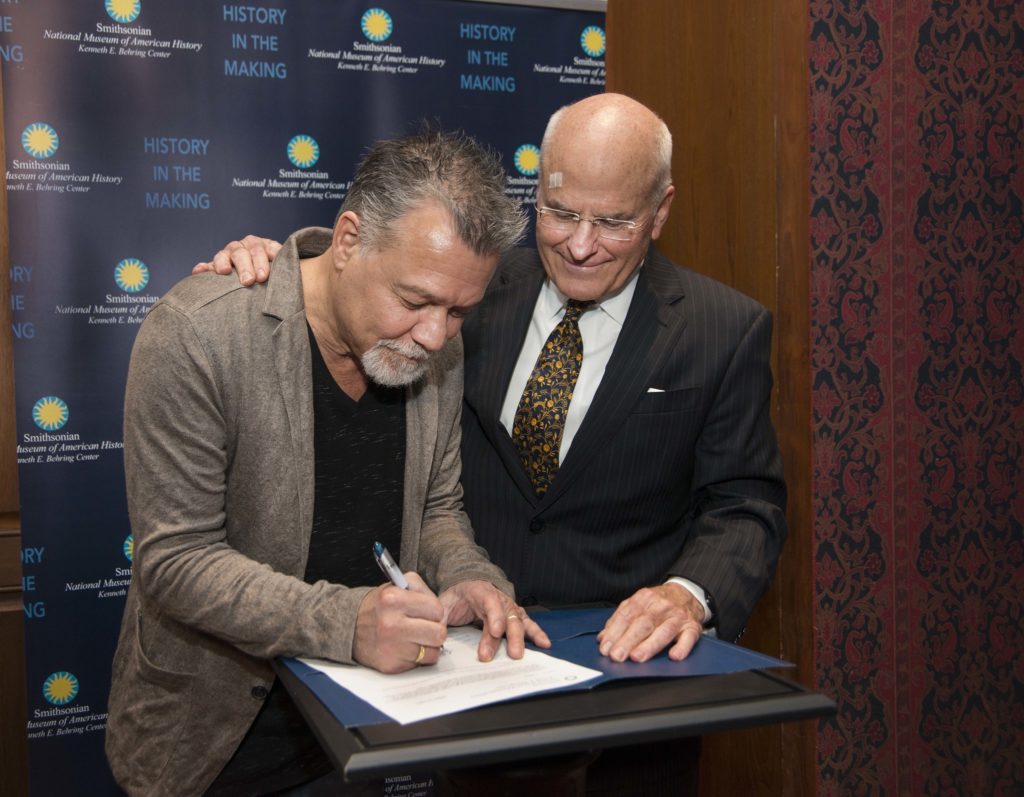
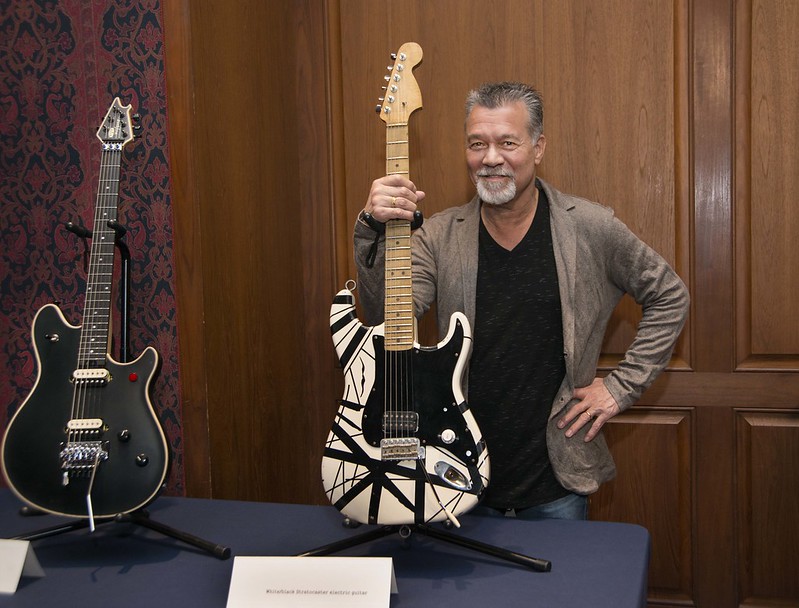
“Guitar legend Eddie Van Halen at the National Museum of American History” by national museum of american history is licensed under CC BY-NC 2.0.
Eruption was part of Edward’s warm-up routine and then later part of the Van Halen live show. Recognizable bits and bubbles of Eruption we know today can be heard on Van Halen soundboard bootlegs as far back as 1975. These earlier versions of Eruption are prior to Ed incorporating tapping into his style, and what some consider the birth of shred. Before the internet and file sharing, bootleg tapes of early Van Halen performances flooded high school hallways, parking lots, and music collector shows all across the United States. Now, many of those same live Van Halen recordings are archived and available online. A favorite early performance video of Eruption is the 1978 performance.
Time will tell – maybe an earlier recording of Eruption is memorialized on a cassette tape or beta-max video stored in a shoebox in a southern California attic, waiting to be uploaded to the internet and take the world by “wow”.
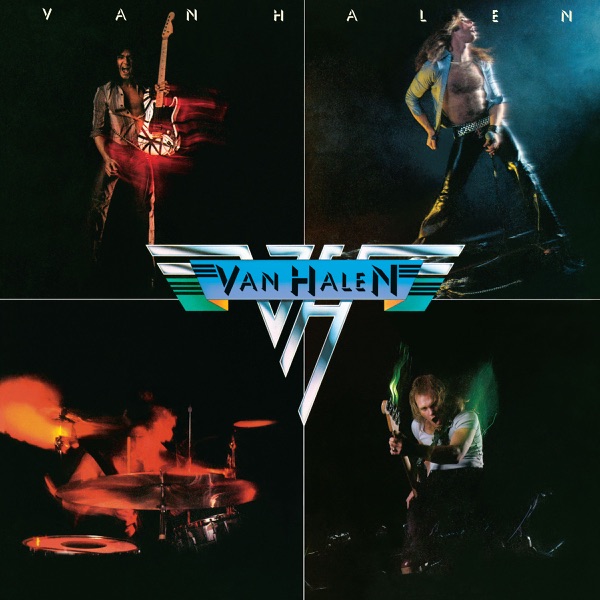
Eruption (Instrumental) first appeared as Track 2 on Van Halen I, released February 10th, 1978. Since the 1978 debut, Eruption also appears on a few Greatest Hits and the Tokyo Dome Live in Concert release. Running with the Devil was Van Halen’s lead track on Van Halen’s debut album and the first single released to radio. The A-side track had the band banging on the door to let the world know this guitar-charged, southern California band was playing for keeps and changing rock-radio. It was track 2, the B-Side to Running with the Devil; Eruption, that kicked down the door and the let world know Edward Van Halen by name.
Well documented in the book Van Halen Rising by Greg Renoff it was during the recording session on September 8, 1977, that famed record producer Ted Templeman heard Eddie practicing Eruption and asked “What the Hell is That?” With an expletive, Tempelman said roll tape… legend has it Don Landee already was. A few takes later, Eruption was now eternal. The funny thing… Ed was never quite happy with the Eruption solo, always acknowledging mistakes that he had made, thinking he could have played it better.
The idea of Eruption being recorded and put on the record was not something Van Halen or Eddie intended. The solo had been a piece that was played as part of the live performances, usually with Eddie’s back facing the audience.
It’s the first question most people have when hearing Eruption for the first time; What Kind of Guitar is That?
Named by his fans as Frankenstein or the Frankenstrat, the guitar Eddie Van Halen played on Eruption, was an essential factor in making the Van Halen sound so unique and turns out to be one he built on his own from existing pieces of other guitars.
In his interview with Denise Quan and the topic of Rock and Roll and reinvention, Ed stated “Crossing a Gibson with a Fender was out of necessity”. Nothing like the Frankenstrat had ever existed. And for this reason why some include Ed in the conversation with Les Paul himself.
Never satisfied with assembly-line guitar body styles and tones, when Eddie wasn’t playing guitar he was deconstructing and modifying them and eventually, trying to put them back together. All in search of the perfect tool to master his craft and realize a sound that screamingly represented an unmistakeable roar that lived deep inside.
Constant tinkering not only resulted in a ton of mistakes and crossed-wire jolts, but also brought to life the Frankenstat. A living, breathing six-string, unmistakable in style and tone. Melded, cut, chiseled, glued, and soldered, the Frankenstrat was its own composition of slapped-together wood pieces. The neck made of maple and the body of ash, brought to life from a pile of factory seconds. Hardwired and enclosed in paraffin wax is a Gibson PAF Humbucker Pickup, invented by Seth Lover in 1955 and most notably used with Les Paul guitars. Completed with larger fret wires set with crazy glue. And don’t forget the tremolo arm, from a 1958 Fender Stratocastor.
Commanding attention on the cover of the debut Van Halen album is Ed with his yet to be named Frankenstrat. Back then, his guitar was just known as “the black and white” guitar. Firmly grasping the guitar neck as if an accomplished lion tamer, Ed appears to have completed some primary rite of passage, photographed with the slightest artistic motion blur. Decorated and layered in a striking striped visual pattern, first black and white and later with the addition of red, an unmistakable design that soon became a visual pattern synonymous with the Van Halen sound.
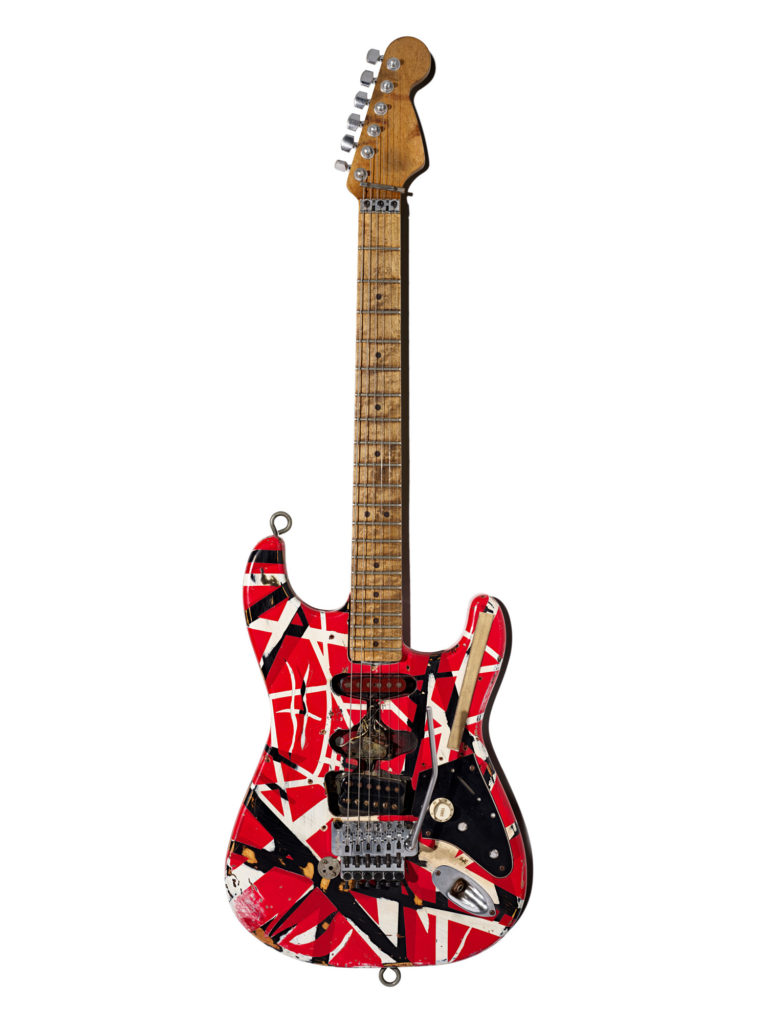

by Eden, Janine and Jim from New York City
is licensed under CC BY 2.0.
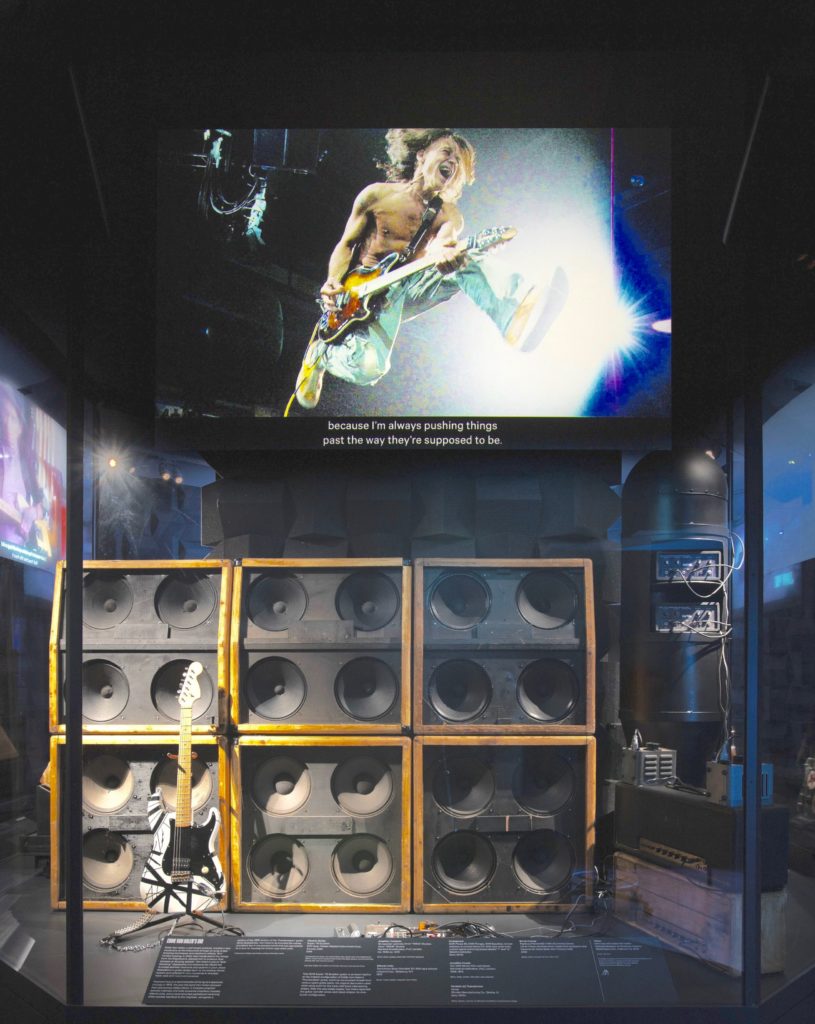
Ed had several mid to late 1960’s era Marshall Superlead amplifiers that powered the early days of Van Halen, and the 1968 is credited with contributing to the Van Halen sound and, specifically, Eruption. These amps would be modified to some degree by the famed Jose Arredondo. If there is only one thing that guitar gear forums would agree on, it is that Ed didn’t use any guitar gear straight of of the box until years later when he was able to produce his own line of EVH gear, so modifications were definite. More importantly, when he played live, recreating the sound or performance, Ed could reproduce what was recorded on the record. Studio trickery was always minimal and that is what was always the most impressive. What may be the most interesting device used to help create the Eddie Van Halen Brown Sound was a Ohmite Variac transformer. The transformer allowed the control of the amount of voltage flowing to the amplifier itself. Controlling the voltage allowed for more control and a consistent sound regardless of volume. Essentially, the variant ac transformer was actually depriving electricity that flowed to the amplifier as it was designed. Ed would have the Variac set at 89 as opposed to the typical 120 voltage from the wall, creating the now recognizable sound. Rick Beato and Rhett Shull have a great video experimenting with the Variac transformer, comparing and contrasting different settings to get as close as possible to the often described Brown Sound. I think they have nailed it, even describing it as having “more sag…” and “… very spongy” when using the Variac. An MXR Phase 90, a single knob effect box designed by Keith Barr, not a flanger, produced the iconic sweeping sound most notably at the end of Eruption. Encased in orange with the four stage phaser that would change the speed of the sweeping phase effect with a nob dial control. Some mistake this sound for a flanger that Ed would use at times, but it was in fact the MXR 90 Phaser used on Eruption. Years later, after Jim Dunlop bought MXR, an Eddie Van Halen signature MXR pedal was produced with the distinct Van Halen Red, White and Black pattern. Along with MXR, it is noted that Ed would use an Echoplex Solid-state EP-3 and Univox EC-80 housed in a World War 2 era practice bomb shell casing. Standing over 10 feet tall, the WWII practice bombshell was quite the visual spectacle but, to ensure the delicate mechanics and sensibilities of the echoplex during the chaos of a Van Halen live stage show, what else could one use? …ok maybe a little overboard; definitely not out of the box. The Echoplex was modified with a motor that allowed for a much lower and slower tape delay. The tape speed would determine the delay while a feedback variable allowed for a repetitive effect. Many players would also use the Echoplex with the delay effect turned off and just run the sound through its tubed filters.
Recording of Eruption as well as all other tracks on Van Halen I was done at Sunset Sound Recorders in Hollywood, California with producer Ted Templeman.
Los Angeles-based musician and producer Brian Kehew, Drew Dempsey and Paul Camarata share an incredible listen to some of the room mics and studio outakes from the Eruption recording session at Sunset Sound.
Like many Van Halen fans who were amazed when they first heard Eruption, I had been wondering if a tribute to Eddie Van Halen would happen in any star-studded, organized fashion. I wasn’t surprised to read about the Grammy Awards essentially snubbing the life-time achievements of Edward Van Halen at the time of his passing; I haven’t watched the out-of-touch awards show in years.
However, I was somewhat disappointed in the established headlining musicians that are recognizable names and players, especially of the hard rock and heavy metal genre as a whole, when they failed to organize any kind of collective tribute to Edward Van Halen. I understand individual artists and guitar greats of all types have acknowledged the influence of Eddie Van Halen, and paid their respects to Eddie in their own way. I also understand as a fan I am not owed anything. On the flip side (or b-side) not making a truly memorable event happen out of respect to the enormous cultural impact Eddie has left behind seems deafening. Do the amplifiers simply get turned off, or fade away?
Then, I thought… really… even if anything like that happened – with no disrespect to those who were the closest to Ed, that most likely would have been (and should have been) involved – when it comes down to it… a pressed out star-studded affair, if I can be so bold to say, would be largely unsatisfying to all.
It seems like the only organized celebration of any kind that would work is if it was the fans that were the headliners.
A way to truly showcase the influence and impact of his artistry on a global scale.
Edward’s self-taught style changed the perceptions of what a guitar could do in one fell swoop.
“Eruption” may very well be the most influential piece of music to inspire anyone to become a musician. And that is why this idea of a Day of Eruption, to celebrate and share the ground-breaking piece of music, is something that we as fans could do successfully and continue his legacy.
In giving back to the community, Edward Van Halen spent over a decade working with Mr Holland’s Opus, a nonprofit foundation whose mission is to help build out music programs in low-income communities. With his passing, Edward left a monumental seven figure donation in support of music eduction and helping students develop a love for music.
DISCLAIMER
This site is not affiliated with Van Halen, or EVH.
The goal of this site is to influence a recognized Day Of Eruption, to celebrate the work of Eddie Van Halen and continue his cultural impact.
Photo credit has been given when known. If there’s a photo you want credited or removed, please let me know: info@dayoferuption.com